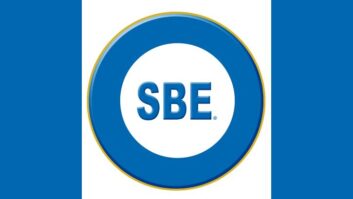As we do annually around this time, Radio World checked in with the leadership of the Society of Broadcast Engineers about highlights of the year and SBE’s goals for the next 12 months.
President Ted Hand answered our questions.
Among highlights of 2024 was the publication of Broadcast Station Self-Inspection Guides in partnership with the National Association of Broadcasters. Guides for FM and TV stations were released in the spring, and a guide for AM stations followed in September. Still in the works are guides for LPFMs, distributed TV services and FM translators, which SBE hopes to release in early 2025.
[Read: “Self-Inspection Guides Are a Powerful New Tool”]
Hand was enthusiastic about the launch of Eastern Europe Chapter 148, based in the Republic of Georgia, and in October he attended a conference in Uzbekistan organized by Chapter 148 Chair Davit Robakidze.
“And we continue with the heart of what SBE is: our educational certification and mentoring programs,” he said.
SBE Ennes Workshops continue to be a success, including sessions at the spring NAB Show about RF and media over IP; the latter workshop was completely full.
SBE also continues to develop its Technical Professional Training and Mentor Programs. “Mentors and mentees are always welcome,” Hand said.
A society member since 1981, Hand was reelected as SBE president in September, running unopposed. He retired from his role as director of engineering and operations at Cox Media Group’s WSOC(TV) in Charlotte, N.C., in June. While he still does RF consulting, most of his energy now is geared toward his second term.

Search committee
Hand is heading a search committee to replace Executive Director Jim Ragsdale, whom SBE said left in October to pursue another career opportunity. That news was unexpected, and SBE did not provide further details about his departure.
Ragsdale was the second full-time executive director of the society, having succeeded John Poray in 2021.
The position has been posted and the committee is gathering résumés. “We’ll be interviewing candidates and we will turn it around as quickly as possible,” Hand said.
Hand is pleased with SBE’s international growth. “We’re very successful in the U.S. and North America but we’re trying to move toward a more global reach for SBE,” he said. A virtual chapter in Canada is moving along nicely.
SBE hopes to get a chapter going in Australia and has been in talks about an educational partnership there.
To support such growth, Hand believes the society needs to adapt its educational and certification programs to regulations and practices in other countries. The society is also exploring the possibility of translating its programs and content into other languages.
But SBE’s 100+ local chapters are likely to remain its hallmark.
“There are a lot of good chapters in the U.S. doing excellent work,” Hand said. “Some chapters have fallen a bit, and we’re working to help them get back on track.” Activities such as transmitter site tours help to engage membership; Hand participated in one recently with Charlotte’s Chapter 45. “We’re coming up with ideas for programming and content and trying to help the best we can,” he said.

Exploring AV
Nourishing society membership is a constant challenge given the demographics of the engineering profession. The organization was at its largest in 2004, with approximately 5,900 members. Today it has around 3,800. A membership drive this year attracted 80 people.
This fall the society awarded five rising broadcast engineers its annual Ennes Scholarships. But attracting youth into the profession remains a challenge. “Our core group of members isn’t getting any younger,” he said.
To help, SBE has considered offering production-based AV certifications in fields like education or religious work. “We do RF, we do streaming and now we’re trying to attract AV personnel in school or ministry settings who are looking for training,” said Hand. He directs and runs cameras for his local church every Sunday and knows that many people are eager to learn and become certified.
For better coordination, Hand said SBE’s educational and certification committees now meet jointly once a year in addition to their ongoing regular meetings.
“They’re working hand-in-hand because if we’re offering certification, we want to be sure we have the webinars to help people prepare for the exams,” he said.
Hand said the society is also in talks with IEEE’s Broadcast Technology Society about possible educational partnerships.
The SBE has gotten positive feedback about the Broadcast Station Self-Inspection Guides but Hand wants to take a step further in 2025 to address the shortage of inspectors for the Alternative Broadcast Inspection Program.
“A lot of the guides help stations with what they need to pass inspection,” Hand indicated, “but we’re trying to fill the gap by creating a certification level for inspectors on the other side.”

Hand is proud of SBE’s annual compensation survey. It continues to show that individuals who hold SBE certifications earn higher salaries as compared to their non-certified counterparts. “It pays to be SBE-certified,” he said.
A certification lasts for five years. “It’s no substitute for hard work,” Hand said, “but the data shows it makes a difference.”
While many members stay current with their SBE certifications, lapses do occur. In response, SBE is promoting its Diamond Project, in honor of the society’s 60th Diamond Anniversary. If your certification lapsed before Jan. 1, 2023, you have until the end of this year to regain it without having to retake the necessary exam.
SBE also continues to focus on protections in the RF spectrum. A recent focus has been in the upper 6 GHz band, which could be allocated toward wireless microphones, among other devices. The organization has also focused on existing bands in the Part 74 spectrum.
Spectrum Manager RJ Russell and Frequency Coordination Chair Bob Weller are working with the Department of Defense to ensure spectrum protection around military bases. “Around areas like Huntsville, Ala., and Norfolk, Va., this is a very big deal, and by all accounts our efforts are going very well,” Hand said.





